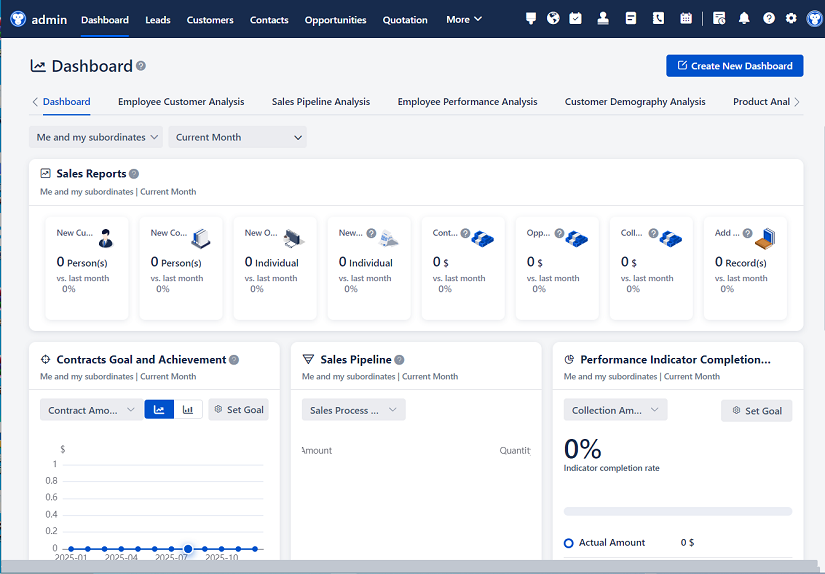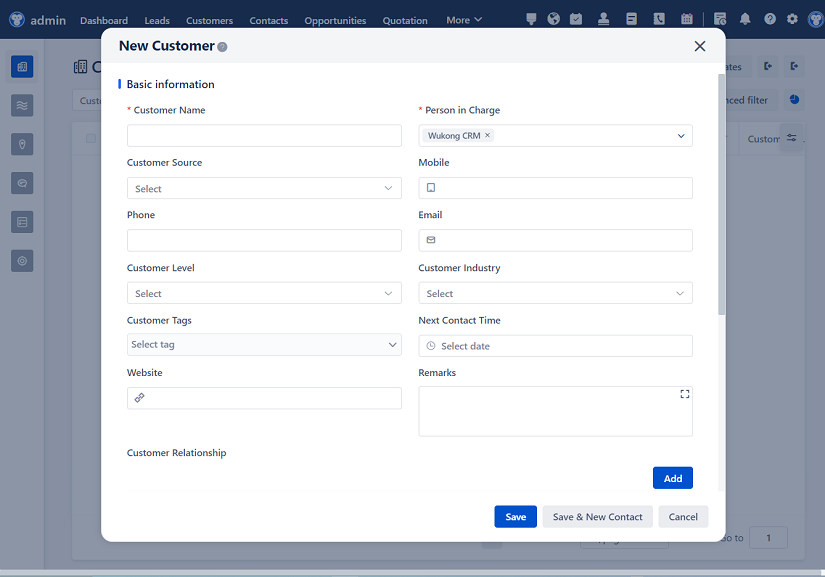
△Click on the top right corner to try Wukong CRM for free
You know, I’ve been thinking a lot lately about how businesses are changing the way they interact with customers. It’s not just about emails or phone calls anymore. People are on their phones all the time, and they expect companies to be right there with them—wherever they are, whenever they want. That’s why I’ve been really fascinated by this whole idea of using WeChat as a platform for enterprise CRM systems. I mean, WeChat isn’t just a messaging app anymore. It’s practically a lifestyle platform in China. People use it to chat, pay bills, order food, book appointments, and even manage their work. So why not use it for customer relationship management too?
Let me tell you, when I first heard about companies building CRM systems on WeChat, I was skeptical. I thought, “How can a social app handle something as complex as enterprise-level customer management?” But then I started digging deeper, and honestly, it makes a ton of sense. Think about it—WeChat has over a billion active users. If your customers are already on there, why force them to download another app or log into a clunky website? Just meet them where they are. That’s smart business.
Free use of CRM system: Free CRM
So here’s how it usually works. Companies create what’s called a WeChat Official Account or a Mini Program. These aren’t just simple chatbots or info pages. They’re full-blown applications that can integrate directly with a company’s backend CRM system. That means when a customer messages the company through WeChat, that message doesn’t just go to some inbox. It gets logged into the CRM, tied to the customer’s profile, and can even trigger automated workflows. Pretty cool, right?
I remember talking to a guy who works for a retail chain in Guangzhou. He told me they used to struggle with customer follow-ups. Sales reps would take notes on paper or in spreadsheets, and half the time, the info never made it into their system. But now, since they’ve integrated their CRM with WeChat, every interaction—whether it’s a message, a service request, or even a product inquiry—gets captured automatically. And the best part? The customer doesn’t have to do anything differently. They just chat like they normally would.

And it’s not just about capturing data. The real magic happens in personalization. Because WeChat knows so much about users—their location, their purchase history, even their browsing behavior—companies can tailor their responses in real time. Imagine getting a message from a brand that says, “Hey, I see you were looking at our winter coats last week. It’s getting cold, so here’s a 15% discount just for you.” That kind of thing feels personal, not robotic. And people respond to that.

I’ve also noticed that customer service has gotten way more efficient. Before, if you had an issue, you might have to call a hotline, wait on hold, and then explain your problem three times. Now, with WeChat CRM, you can just send a message, attach a photo if needed, and get a response in minutes. Some companies even use AI-powered chatbots to handle common questions, freeing up human agents for more complex issues. It’s faster, cheaper, and honestly, a lot less frustrating for everyone involved.
But it’s not just about service. Sales teams are using this too. I spoke with a sales manager at a tech firm who said his team uses WeChat CRM to track leads from the very first interaction. When someone follows their Official Account or engages with a Mini Program, that person becomes a lead in the system. Then, based on their behavior—what they click on, how often they message—the CRM scores them and suggests the best time to reach out. It’s like having a digital assistant that knows exactly when to make the move.
And let’s not forget marketing. WeChat’s ecosystem allows for super targeted campaigns. You can send push notifications, share articles, run mini-games, or even host live streams—all within the app. And because everything is tied to the CRM, you can measure exactly what’s working. Did that discount campaign lead to more purchases? Did that live stream increase engagement? You can see it all in real time.
Now, I know what you’re thinking—“Isn’t this a privacy nightmare?” And honestly, that’s a fair concern. WeChat collects a lot of data, and not everyone is comfortable with that. But here’s the thing: most users in China are okay with it because they get value in return. Faster service, better deals, more convenience. As long as companies are transparent and follow data protection rules, it can be a win-win.
Still, it’s not all smooth sailing. Integrating a CRM with WeChat isn’t exactly plug-and-play. You need developers who understand both the WeChat API and your CRM platform. And if you’re using a legacy system, it might take some serious tweaking to make everything talk to each other. I’ve heard stories of companies spending months just on the integration phase. So yeah, it’s not for the faint of heart.
Another challenge is user adoption. Just because you build it doesn’t mean they’ll come. Employees have to be trained to use the new system, and customers need to know it’s even there. One company I read about launched a WeChat CRM but didn’t promote it well. Result? Almost no one used it. So marketing the tool internally and externally is just as important as building it.

But when it works, it really works. I saw a case study from a healthcare provider in Shanghai. They used WeChat CRM to manage patient appointments, send reminders, and even collect feedback after visits. Not only did patient satisfaction go up, but no-show rates dropped by 30%. That’s huge. And for the staff, it meant less time on the phone and more time focusing on care.
Another example is a bank that integrated its CRM with WeChat to offer personalized financial advice. Customers could message a bot, answer a few questions, and get tailored recommendations—like which credit card suits their spending habits or when they should refinance their mortgage. It wasn’t replacing human advisors, but it was a great first step. And again, because it was on WeChat, people actually used it.
I think what’s really exciting is how this model could spread beyond China. I know WeChat isn’t as big in the West, but the concept—using a popular messaging platform to power CRM—is totally transferable. Imagine using WhatsApp, Facebook Messenger, or even iMessage in the same way. Companies in Europe and North America are already experimenting with this. It’s just a matter of time before it becomes standard practice.
And let’s be real—customers want this. Nobody likes filling out forms or waiting on hold. They want quick, easy, and personal interactions. WeChat CRM delivers that. It turns customer service from a chore into a conversation. That’s the future, in my opinion.
Of course, there are risks. Security is a big one. If your CRM is connected to WeChat, you’ve got to make sure that data is protected. A breach could be disastrous. And there’s always the risk of over-automation. If every message feels like it’s coming from a robot, people will tune out. The key is balance—using tech to enhance human connection, not replace it.
I also think companies need to be careful about not becoming too dependent on WeChat. It’s a powerful platform, but it’s still controlled by one company—Tencent. If they change their policies or fees, it could mess up your whole system. So it’s smart to have a backup plan or at least a multi-channel strategy.
But overall, I’m really optimistic about this trend. It’s not just about technology—it’s about meeting people where they are and making their lives easier. And in today’s fast-paced world, that’s what sets great companies apart.
So yeah, enterprise CRM on WeChat? It’s not just a gimmick. It’s a smart, practical solution that’s already changing how businesses operate in China. And who knows? Maybe one day, we’ll all be managing our customer relationships through our favorite messaging apps. Wouldn’t that be something?
FAQs (Frequently Asked Questions)
Q: Can small businesses use WeChat CRM too, or is it only for big enterprises?
A: Absolutely, small businesses can use it too! In fact, many small retailers and service providers in China already do. WeChat’s tools are scalable, so whether you have 10 customers or 10,000, you can set up a CRM system that fits your needs.
Q: Do customers need to download anything to use WeChat CRM?
A: Nope. That’s the beauty of it. As long as they already have WeChat installed—which most people in China do—they can interact with your CRM through the app without downloading anything extra.
Q: Is it expensive to build a CRM on WeChat?
A: It depends. The WeChat platform itself doesn’t charge much for basic features, but the cost comes from development, integration, and maintenance. If you’re using a simple setup, it can be affordable. But complex systems with AI and deep CRM integration will cost more.
Q: Can WeChat CRM work outside of China?
A: Technically, yes, but WeChat’s user base outside China is much smaller. However, the same concept can be applied using other messaging platforms like WhatsApp or Messenger in different regions.
Q: How do companies ensure data privacy with WeChat CRM?
A: They use encryption, follow local data laws (like China’s PIPL), and limit access to sensitive information. It’s also important to be transparent with users about what data is collected and why.
Q: Can WeChat CRM replace traditional CRM systems?
A: Not entirely. It’s best used as an extension of your existing CRM, not a replacement. It adds a powerful communication layer but still relies on the core CRM for data storage and management.
Q: What happens if WeChat goes down? Will the CRM stop working?
A: During outages, real-time messaging might be affected, but your CRM data is usually stored separately. Once WeChat is back up, sync usually resumes automatically. Still, it’s wise to have alternative communication channels.
Q: Are there any industries where WeChat CRM doesn’t work well?
A: It works best in customer-facing industries like retail, healthcare, banking, and hospitality. For highly regulated or internal processes (like manufacturing or logistics), it might not be as useful—though it can still support customer communication aspects.
Related links:
Free trial of CRM
Understand CRM software

△Click on the top right corner to try Wukong CRM for free